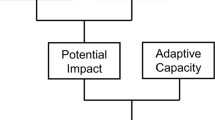Abstract
The physical and economic impacts of climate warming in the Mackenzie River Valley, Northwest Territories, Canada are estimated using a combination of stochastic modelling, econometric-modelling and input-output analysis. The attempt was to illustrate the utility of using analytical models for long-term impact assessment as well as to estimate the potential impacts from projected climate warming in the region. A scenario approach, based on three global circulation models, was used, with an emphasis on modelling climate variability, river ice conditions and economic impacts. The transportation system was used as a central focus linking the physical and socio-economic components. Despite the significant warming projected for the region, results show the economic impacts from changes in transportation to be relatively minor, with the greatest changes being in the tertiary, or service, sector.
Similar content being viewed by others
References
Adam, K. M.: 1978, ‘Building and Operating Winter Roads in Canada and Alaska’, Environmental Studies, No. 4, Department of Indian and Northern Affairs, Ottawa, 221 pp.
Allen, W. T. R., 1977, Freeze-up, Break-up and Ice Thickness in Canada. Atmospheric Environment Service, Fisheries and Environment Canada, Publication CL1-1-77, 185 pp.
Barry, R. G.: 1986, ‘Impacts of CO2 Doubling on Snow and Ice in the Canadian Arctic’, inProceedings of the Impact of Climate Change in the Canadian Arctic, Orillia, Ontario, pp. 67–78.
Billelo, M. A.: 1980, ‘Maximum Thickness and Subsequent Decay of Lake, River and Fast Sea Ice in Canada and Alaska’, U.S. Army, Cold Regions Research and Engineering Laboratory Report 80-6, 160 pp.
Burns, B. M.: 1973,The Climate of the Mackenzie Valley-Beaufort Sea, Department of the Environment, Atmospheric Environment Service, Climatological Studies, no. 24, vol. 1, 227 pp.
Carter, D. L.: 1988, ‘Climatic Change and Permafrost: The Record from Surficial Deposits’, Draft, 5 pp.
Cohen, S.: 1988, Mimeo, Atmospheric Environment Service, Downsview, Ont.
Crampton, C. B. and Rutter, N. W.: 1973, ‘A Geoecological Terrain Analysis of Discontinuously Frozen Ground in the Upper Mackenzie Valley, Canada’, inProceedings of the Second International Permafrost Conference, Washington, D.C., pp. 101–105.
Etkin, D.: 1988, ‘Greenhouse Warming: Consequences for Arctic Climate’, Draft, Atmospheric Environment Service, Downsview, Ont., 21 pp.
Haan, c. T.: 1977,Statistical Methods in Hydrology, Iowa State University Press, Iowa City, 378 pp.
Hansen, J., Russell, G., Rind, D., Stone, P., Lacis, A., Lebedeff, S., Ruedy, R., and Travis, L.: 1983, ‘Efficient Three-Dimensional Global Models for Climate Studies: Models I and II’,Mon. Wea. Rev. 111, 609–662.
Hunt, A. D., MacNabe, G. M., Terer, J. S.: 1974,Mackenzie Valley and Northern Yukon Pipelines, Socio-Economic and Environmental Aspects, Ottawa: Indian and Northern Affairs, 197 pp.
Kates, R. W.et al.: 1985,Climate Impact Assessment, John Wiley and Sons, New York.
Kellogg, W. W.: 1975, ‘Climatic Feedback Mechanisms Involving the Polar Regions’, in Weller, G. and Bowling, S. A. (eds.),Climate of the Arctic, Geophysical Institution, University of Alaska, pp. 11–116.
Kukla, G. J.: 1979, ‘Climatic Role of Snow Covers’, inProceedings of Sea Level, Ice and Climatic Change, Canberra, December, 1979, IAHS Publication no. 131, pp. 479–107.
Little, R. L. and Krannich, R. S.: 1988, ‘A Model for Assessing the Social Impacts of Natural Resource Utilization on Resource Dependent Communities’,Impact Assess. Bull. 6, No.2, 21–36.
Lonergan, S. C. and Woo, M-K.: 1990, ‘Climate Change and Transportation in Northern Canada: An Integrated Impact Assessment’, Report to the Canadian Climate Centre, Atmospheric Environment Service, Downsview, Ontario.
Manabe, S. and Wetherald, R. T.: 1987, ‘Large Scale Changes of Soil Wetness Induced by an Increase in Atmospheric Carbon Dioxide’,J. Atmos. Sci. 44, 1211–1235.
McKenney, M. S. and Rosenberg, N.: 1991, ‘Climate Data Needs from GCM Experiments for Use in Assessing the Potential Impacts of Climate Change on Natural Resource Systems’, RFF Discussion Paper INR91-15. Resources for the Future, Washington, D.C.
Meyersohn, R.: 1972, ‘Leisure’, in Campbell, A. and Converse, P. E. (eds.),The Human Meaning of Social Change, Russel Sage Foundation, New York, 205–228.
Miller, R. E. and Blair, P.: 1985,Input-Output Analysis, Prentice-Hall, Englewood Cliffs.
Moss, M. E. and Tasker, G. D.: 1987, ‘The Role of Stochastic Hydrology in Dealing with Climatic Variability’,Int. Div. Hydrol. Sci. Public. 168, 201–207.
Prowse, T. D.: 1987, ‘Ice Jam Characteristics, Liard-Mackenzie River Confluence, N.W.T.’,Canad. J. Civ. Eng. 13, 653–665.
Reed, D. N.: 1986, ‘Simulation of Time Series of Temperature and Precipitation over Eastern England by an Atmospheric General Circulation Model’,J. Clim. 6, 233–253.
Robinson, P. and Finkelstein, P.: 1991, ‘The Development of Impact-Oriented Climate Scenarios’,Bull. Amer. Meteorol. Soc. 72(4, 481–490.
Schlesinger, M. E.: 1988, ‘General Circulation Model Simulations of CO2-Induced Equilibrium Climate Change’, in French, H. (ed.),Proceedings of the Impact of Climatic Change on the Canadian Arctic, Orillia, Ontario, March 1988, 51 pp.
Schlesinger, M. E. and Mitchell, J.: 1987, ‘Climate Model Simulations of the Equilibrium Climatic Response to Increased Carbon Dioxide’,Reviews of Geophysics 25, 760–798.
Schlesinger, M. and Zhao, Z.: 1988, ‘Seasonal Climate Changes Induced by Doubled CO2 as Simulated by the OSU Atmospheric GCM/Mixed-Layer Ocean Model’, Oregon State University Climate Research Institute Report, Corvallis, Oregon.
Smith, M. W.: 1986, ‘The Significance of Climate Change for the Permafrost Environment’, in H. French (ed.),Proceedings of the Impact of Climate Change in the Canadian Arctic, Orillia, Ontario, March, 1988, pp. 67–78.
Wigley, T. M. L., Jones, P. D., and Kelly, P. M.: 1980, ‘Scenario for a Warm, High CO2 World’,Nature 283, 17–21.
Woo, M-K.: 1992, ‘Application of Stochastic Simulation to Climatic-change Studies’,Climatic Change 20, 313–330.
Author information
Authors and Affiliations
Rights and permissions
About this article
Cite this article
Lonergan, S., Difrancesco, R. & Woo, MK. Climate change and transportation in Northern Canada: an integrated impact assessment. Climatic Change 24, 331–351 (1993). https://doi.org/10.1007/BF01091854
Received:
Revised:
Issue Date:
DOI: https://doi.org/10.1007/BF01091854




